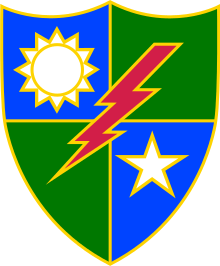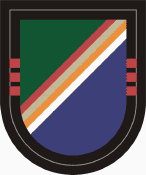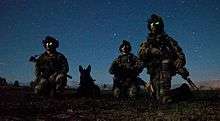3rd Ranger Battalion
The 3rd Ranger Battalion, currently based at Fort Benning, Georgia, is the third of three Ranger Battalions belonging to the United States Army's 75th Ranger Regiment.
| 3rd Battalion, 75th Ranger Regiment | |
|---|---|
 3rd Ranger Battalion shoulder sleeve insignia | |
| Active | 1943–45,1954–56, 1969–71, 1984–present |
| Country | |
| Branch | |
| Type | Specialized Light infantry |
| Role | Special operations |
| Size | Battalion |
| Part of | |
| Garrison/HQ | Fort Benning, Georgia |
| Engagements | World War II:
Vietnam War on Terror |
| Insignia | |
| Distinctive unit insignia |  |
| Unit beret flash |  |
History
World War II
After the impressive performance of the 1st Ranger Battalion in the North Africa Campaign the 3rd Ranger Battalion was organized on 19 June 1943 in Morocco, the battalion was made up of American volunteers and led by Major Herman Dammer.[1]
The battalion participated in the invasion of Sicily, the invasion of Italy, the battalion was destroyed at the Battle of Cisterna in early 1944.[2]
This unit was consolidated 10 August 1944 with Company F, 475th Infantry Regiment (Long Range Penetration, Special) (constituted 25 May 1944 in the Army of the United States), and consolidated unit designated as Company F, 475th Infantry Regiment. This unit was deactivated 1 July 1945 in China.
Post-WWII
The unit was redesignated 21 June 1954 as Company F, 75th Infantry Regiment, in the Army of the United States, and was allotted on 26 October 1954 to the Regular Army. It was activated 20 November 1954 on Okinawa, and was inactivated there on 21 March 1956.
The unit was again activated on 1 February 1969 in Vietnam, and was again inactivated on 15 March 1971 in Vietnam.
This unit was again redesignated 3 October 1984 as Headquarters and Headquarters Company, 3rd Battalion, 75th Infantry, and activated at Fort Benning, Georgia (organic elements concurrently constituted and activated).
Headquarters and Headquarters Company consolidated 3 February 1986 with former Company A, 3rd Ranger Infantry Battalion 3rd Battalion, 75th Infantry Regiment, concurrently redesignated as the 3rd Battalion, 75th Ranger Regiment.
On 20 December 1989, the 75th Ranger Regiment was committed to Operation Just Cause, in Panama. Along with the 2nd Ranger Battalion, Companies A and B of the 3rd Battalion conducted an airfield seizure of the Rio Hato Airfield, and Company C participated along with the 1st Ranger Battalion to seize the airfield at Torrijos/ Tocumen Airport, and subsequent combat operations contributed significantly to the United States victory in Panama.
In August 1993, elements of Company B of the 3rd Ranger Battalion and the battalion headquarters deployed to Somalia as part of Task Force Ranger. After several successful missions, on 3 October 1993 exactly nine years from the activation of the battalion, they performed a courageous daylight assault where they were engaged in the most intense ground combat for U.S. troops since the Vietnam War.
War on Terror
After the terrorist attacks of 11 September 2001, the 3rd Ranger Battalion deployed to Afghanistan in support of Operation Enduring Freedom. On 19 October 2001, during the 2001 invasion of Afghanistan, 200 Rangers of 3rd Battalion, 75th Ranger Regiment spearheaded ground forces by conducting an airborne assault to seize Objective Rhino;[3] Spc. Jonn J. Edmunds and Pfc. Kristofer T. Stonesifer were the first combat casualties in the War on Terror when their MH-60L helicopter crashed at Objective Honda in Pakistan, a temporary staging site used by a company of Rangers from 3rd Battalion.[4][5] During the Battle of Tora Bora in December 2001, a CIA Jawbreaker team (small group of CIA SAD ground branch operators) requested that the 3rd Battalion, 75th Ranger Regiment be inserted into the mountains to establish blocking positions along potential escape routes out of Tora Bora into Pakistan. They would serve as the 'anvil' whilst Green Berets with the AMF (Afghan Militia Forces) would be the 'Hammer,' with attached Air Force Combat Controllers, the Rangers could direct airstrikes onto enemy concentrations or engage them in ambushes, but this was denied.[6]
In 2003, the 3rd Battalion was called upon to participate in the 2003 invasion of Iraq. On 24 March 2003, 3rd Battalion 75th Ranger Regiment conducted a combat drop onto H-1 Air Base, securing the site as a staging area for operations in western Iraq. On the night of 31 March/April 1, 2003, Delta Force and 3/75th captured the Haditha Dam complex and held it for a further 5 days.[7]
At the end of 2003, the battalion deployed again, this time sending elements of the battalion to both Afghanistan and Iraq. The battalion deployed multiple times in support of Operation Iraqi Freedom until summer 2010. The battalion continues to deploy in support of Operation Enduring Freedom. Primary tasks include: direct action, national and international emergency crisis response, airfield seizure, airborne and air assault operations, special reconnaissance, intelligence and counter intelligence, combat search and rescue, personnel recovery and hostage rescue, joint special operations, and counter terrorism.
On 18 April 2010, ISOF troops, supported by US troops, carried out a night-time raid on a terrorist safe house near Tikrit in Iraq, the ISOF killed Abu Ayyub al-Masri and Abu Omar al-Baghdadi, the two leaders of ISI; 16 others were also arrested. A US UH-60 Blackhawk helicopter supporting the mission crashed killing a Ranger NCO from 3/75th and wounding the aircrew.[8][9][10]

By mid-2015 each Ranger battalion had completed its 20th deployment in support of both Afghanistan and Iraq operations. As of 28 March 2016, since the War on Terror began, 31 Rangers from the battalion have been killed.[11]
It was reported that on the evening of 26 April 2017, 50 Rangers from 3/75th joined 40 Afghan commandos to conduct a joint US-Afghan operation/raid that was targeting the headquarters of Abdul Hasib, the Emir of ISIS-K, in a village in Achin District, Nangarhar Province, Afghanistan. The force was flown into Mohmand Valley and within minutes were engaged in a heavy, close-quarter firefight, AC-130 gunships, Apache helicopters, F-16 fighters and drones were called in to support the force firefight with ISIS-K militants. The firefight lasted for 3 hours, resulting in 2 Rangers from C and D Companies died of injuries (possibly caused by friendly fire) after being medevaced and a third was also wounded, 35 (including Abdul Hasib and an unspecified number of ISIS-K leaders) ISIS-K militants were also killed.[12][13][14]
Lineage
The 3rd Battalion of the 75th Ranger Regiment traces its lineage to two units; Company H, 475th Infantry Regiment (previously known as the 5307th Composite Unit (Provisional), or "Merrill's Marauders") and Company A, 3rd Ranger Battalion. The units originally had separate lineages, but were then consolidated in 1986.
- Constituted 3 October 1943 in the Army of the United States in the China-Burma-India Theater of Operations as an element of the 5307th Composite Unit (Provisional)
- Consolidated 10 August 1944 with Company F, 475th Infantry (constituted 25 May 1944 in the Army of the United States), and consolidated unit designated as Company F, 475th Infantry
- Inactivated 1 July 1945 in China
- Redesignated 21 June 1954 as Company F, 75th Infantry
- Allotted 26 October 1954 to the Regular Army
- Activated 20 November 1954 on Okinawa
- Inactivated 21 March 1956 on Okinawa
- Activated 1 February 1969 in Vietnam
- Inactivated 15 March 1971 in Vietnam
- Redesignated 2 October 1984 as Headquarters and Headquarters Company, 3d Battalion, 75th Infantry, and activated at Fort Benning, Georgia (organic elements concurrently constituted and activated)
- Headquarters and Headquarters Company consolidated 3 February 1986 with former Company A, 3d Ranger Infantry Battalion (see ANNEX); 3d Battalion, 75th Infantry, concurrently redesignated as the 3d Battalion, 75th Ranger Regiment
Annex
- Constituted 21 July 1943 in the Army of the United States as Company A, 3rd Ranger Battalion; concurrently consolidated with Company A, 3rd Ranger Battalion (Provisional) (organized 21 May 1943 in North Africa), and consolidated unit designated as Company A, 3rd Ranger Battalion.
- Redesignated 1 August 1943 as Company A, 3rd Ranger Infantry Battalion.
- Disbanded 15 August 1944.
- Reconstituted 25 October 1950 in the Regular Army as the 3rd Ranger Infantry Company.
- Activated 28 October at Fort Benning, Georgia.
- Inactivated 1 August 1951 in Korea.
- Redesignated 24 November 1952 as Company A, 3rd Ranger Infantry Battalion.
- Consolidated 15 April 1960 with the 1st Company, 1st Battalion, 2nd Regiment, 1st Special Service Force (activated 9 July 1942), and consolidated unit redesignated as Headquarters and Headquarters Company, 13th Special Forces Group, 1st Special Forces.
- Withdrawn 14 December 1960 from the Regular Army and allotted to the United States Army Reserve (organic elements concurrently constituted).
- Group activated 1 March 1961 with headquarters at Jacksonville, Florida.
- Headquarters and Headquarters Company inactivated 15 April 1963 at Jacksonville, Florida (organic elements inactivated 21 January 1966).
- Former Company A, 3rd Ranger Infantry Battalion, withdrawn 3 February 1986, consolidated with Headquarters and Headquarters Company, 3rd Battalion, 75th Infantry, and consolidated unit redesignated as Headquarters and Headquarters Company, 3rd Battalion, 75th Ranger Regiment (remainder of 13th Special Forces Group, 1st Special Forces – hereafter separate lineage).
Honors
Campaign participation credit
- World War II:
- Algeria-French Morocco (with arrowhead)
- Tunisia
- Sicily (with arrowhead)
- Naples-Foggia (with arrowhead)
- Anzio (with arrowhead)
- Rome-Arno
- Normandy (with arrowhead)
- Northern France
- Rhineland
- Ardennes-Alsace
- Central Europe
- New Guinea
- Leyte (with arrowhead)
- Luzon
- India-Burma
- Central Burma
- Korean War:
- First UN Counteroffensive;
- CCF Spring Offensive;
- UN Summer-Fall Offensive
- Vietnam:
- Counteroffensive, Phase VI;
- Tet 69/Counteroffensive;
- Summer-Fall 1969;
- Winter-Spring 1970;
- Sanctuary Counteroffensive;
- Counteroffensive, Phase VII
- Armed Forces Expeditions:
- Panama (with arrowhead)
- Somalia (with arrowhead)
- Afghanistan (with arrowhead)
- Iraq (with arrowhead)
Decorations
- Presidential Unit Citation (Army) for EL GUETTAR
- Presidential Unit Citation (Army) for SALERNO
- Presidential Unit Citation (Army) for POINTE DU HOC
- Presidential Unit Citation (Army) for SAAR RIVER AREA
- Presidential Unit Citation (Army) for MYITKYINA
- Valorous Unit Award for BINH DUONG PROVINCE
- Valorous Unit Award for MOGADISHU
- Republic of Korea Presidential Unit Citation for UIJONGBU CORRIDOR
- Republic of Korea Presidential Unit Citation for KOREA 1951
- Republic of Vietnam Cross of Gallantry with Palm for VIETNAM 1969
- Republic of Vietnam Cross of Gallantry with Palm for VIETNAM 1969–1970
- Republic of Vietnam Civil Action Honor Medal, First Class for VIETNAM 1969–1970
References
- Cawthorne, Nigel, The Mammoth Book of Inside the Elite Forces, Robinson, 2008 ISBN 1845298217 ISBN 978-1845298210
- Cawthorne, Nigel, The Mammoth Book of Inside the Elite Forces, Robinson, 2008 ISBN 1845298217 ISBN 978-1845298210
- Gal Perl Finkel, Win the close fight, The Jerusalem Post, 21 March 2017.
- Neville, Leigh, Special Forces in the War on Terror (General Military), Osprey Publishing, 2015 ISBN 978-1472807908, p.34-36
- "A NATION CHALLENGED: THE EARLY CASUALTIES; 2 Soldiers Remembered for Their Focus and Patriotism, https://www.nytimes.com/2001/10/23/us/nation-challenged-early-casualties-2-soldiers-remembered-for-their-focus.html
- Neville, Leigh, Special Forces in the War on Terror (General Military), Osprey Publishing, 2015 ISBN 978-1472807908, p.42, p.46–47
- Neville, Leigh, Special Forces in the War on Terror (General Military), Osprey Publishing, 2015 ISBN 978-1472807908, p.93–96, p.118, p.128–129, p.131, p.133–134
- Neville, Leigh, Special Forces in the War on Terror (General Military), Osprey Publishing, 2015 ISBN 978-1-4728-0790-8, p.226
- "2 Most Wanted Al Qaeda Leaders in Iraq Killed by U.S., Iraqi Forces" FoxNews, 19 April 2010.
- Waleed Ibrahim. "Al Qaeda's top two leaders in Iraq have been killed, officials said Monday, in a strike the United States called a "potentially devastating blow" but whose impact analysts said may be limited". Thomson Reuters.
- "75th Ranger Regiment". leadtheway.org.
- "'Friendly Fire' May Have Killed 2 U.S. Soldiers in Afghanistan Raid". The New York Times. 27 April 2017.
- "Army Rangers killed in Afghanistan were possible victims of friendly fire". Army Times. 28 April 2017.
- "Afghanistan IS head killed in raid – US and Afghan officials". BBC. 8 May 2017.
- 3rd Ranger Battalion: Fact Sheet. U.S. Army, Fort Benning. United States of America.
- 75th Ranger Regiment: Fact Sheet. U.S. Special Operations Command. United States of America.
- . Rangers train for 20th deployment to Afghanistan at Fort Knox.